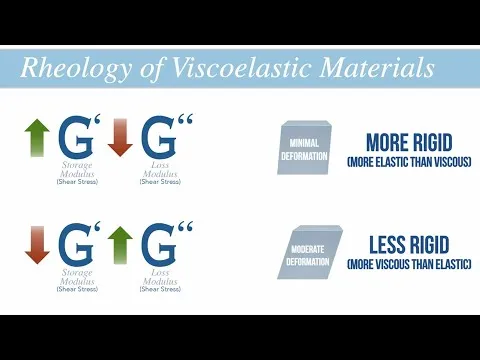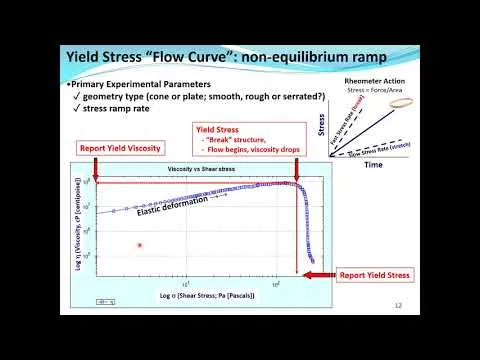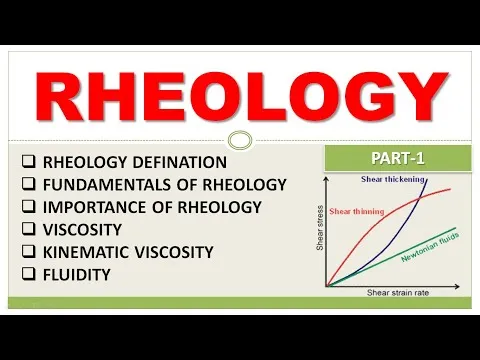
Rheology of Cosmetic Fillers: G E and Tan Delta Aesthetic Minutes #DermalFillers 
Discover the secrets behind the science of cosmetic fillers in this captivating course! Unravel the meanings of G', E', tan delta, cohesivity, and viscoelasticity, and explore their relevance in the world of aesthetic medicine. From the concept of rigidity to the types of stress and strain, this course covers it all. Dive into the differences between Newtonian and non-Newtonian fluids, and learn about the various types of colloids and dispersions. With engaging topics like shear thickening and shear thinning, this course will keep you hooked from start to finish. Don't miss out on this opportunity to enhance your knowledge of filler rheology! #DermalFillers #FillerRheology #Rheology #Fillers ▼
ADVERTISEMENT
Course Feature
![]() Cost:
Cost:
Free
![]() Provider:
Provider:
Youtube
![]() Certificate:
Certificate:
No Information
![]() Language:
Language:
English
![]() Start Date:
Start Date:
2020-04-19 00:00:00
Course Overview
❗The content presented here is sourced directly from Youtube platform. For comprehensive course details, including enrollment information, simply click on the 'Go to class' link on our website.
Updated in [September 25th, 2023]
We considered the value of this course from many aspects, and finally summarized it for you from two aspects: skills and knowledge, and the people who benefit from it:
(Please note that our content is optimized through artificial intelligence tools and carefully reviewed by our editorial staff.)
What skills and knowledge will you acquire during this course?
During this course on the rheology of cosmetic fillers, learners will acquire the following skills and knowledge:
1. Understanding of the basic science behind the rheology of cosmetic fillers.
2. Knowledge of the different states of matter and their relevance to aesthetic medicine.
3. Understanding of the concept of rigidity and its importance in the field.
4. Knowledge of elasticity and its application in aesthetic medicine.
5. Familiarity with Hooke's Law of Elasticity and its significance.
6. Understanding of stress and strain and their relationship to cosmetic fillers.
7. Knowledge of different types of stress and their implications in aesthetic medicine.
8. Familiarity with different types of elastic modulus and their relevance to fillers.
9. Understanding of viscosity and its importance in the field.
10. Knowledge of Newtonian and non-Newtonian fluids and their impact on cosmetic fillers.
11. Familiarity with different types of dispersions and their relevance to aesthetic medicine.
12. Understanding of different types of colloids and their application in fillers.
13. Knowledge of shear thickening and its implications in aesthetic medicine.
14. Familiarity with shear thinning and its relevance to hyaluronic acid gels.
15. Understanding of the spring model of elasticity and its significance in the field.
16. Knowledge of the dashpot model of viscosity and its application in fillers.
17. Familiarity with the Burgers model of viscoelasticity and its relevance to aesthetic medicine.
18. Understanding of complex modulus, storage modulus, and loss modulus.
19. Knowledge of G' and G" and their importance in the rheology of cosmetic fillers.
20. Familiarity with tan delta and its implications in aesthetic medicine.
21. Understanding of cohesivity and its relevance to fillers.
22. Knowledge of E' and E and their application in the field of aesthetic medicine.
Overall, this course will provide learners with a comprehensive understanding of the rheology of cosmetic fillers and its significance in the field of aesthetic medicine.
Who will benefit from this course?
This course on the rheology of cosmetic fillers will benefit individuals in the field of aesthetic medicine, specifically those involved in the application and understanding of dermal fillers. This includes dermatologists, plastic surgeons, cosmetic nurses, and other medical professionals who administer fillers to enhance facial aesthetics.
By learning about symbols and terms such as G', E', tan delta, cohesivity, and viscoelasticity, participants will gain a deeper understanding of the science behind cosmetic fillers. This knowledge is crucial for selecting the appropriate filler for specific aesthetic goals, understanding the behavior of fillers within the skin, and predicting the longevity and effectiveness of the treatment.
Understanding the concepts of rigidity, elasticity, stress, strain, viscosity, and different types of moduli will enable practitioners to make informed decisions when choosing fillers and determining the optimal injection techniques. They will also be able to better assess the risks and potential complications associated with fillers, as well as troubleshoot any issues that may arise during or after treatment.
Course Provider

Provider Youtube's Stats at AZClass
Discussion and Reviews
0.0 (Based on 0 reviews)
Explore Similar Online Courses

Rheology Principles and Applications

Procurement and Contracts Management in NGOs (Part One) Afsoomaali

Python for Informatics: Exploring Information

Social Network Analysis

Introduction to Systematic Review and Meta-Analysis

The Analytics Edge

DCO042 - Python For Informatics

Causal Diagrams: Draw Your Assumptions Before Your Conclusions

Whole genome sequencing of bacterial genomes - tools and applications

Yield Stress Oscillation Rheology and Phase Angle

RHEOLOGY PHYSICAL PHARMACY PART-1 VISCOSITY FLUIDITY


Start your review of Rheology of Cosmetic Fillers: G E and Tan Delta Aesthetic Minutes #DermalFillers